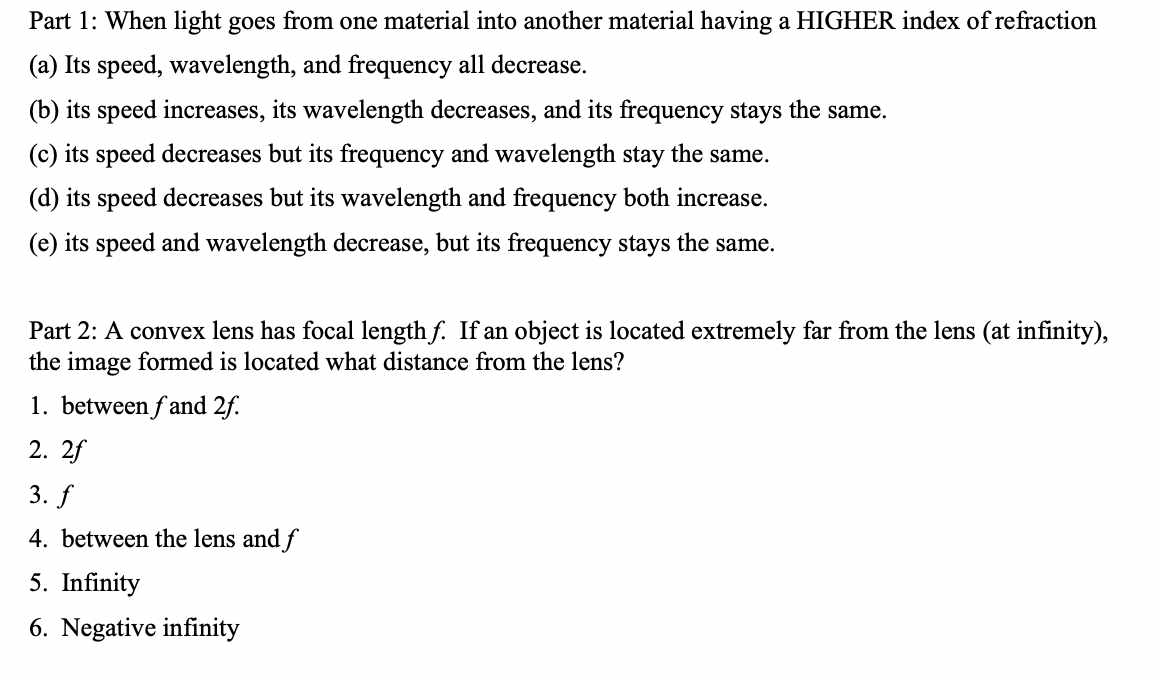Part 1: When light goes from one material into another material having a HIGHER index of refraction (a) Its speed, wavelength, and frequency all decrease. (b) its speed increases, its wavelength decreases, and its frequency stays the same. (c) its speed decreases but its frequency and wavelength stay the same. (d) its speed decreases but its wavelength and frequency both increase. (e) its speed and wavelength decrease, but its frequency stays the same. Part 2: A convex lens has focal length f. If an object is located extremely far from the lens (at infinity), the image formed is located what distance from the lens? 1. between f and 2f. 2. 2f 3. f 4. between the lens and f 5. Infinity 6. Negative infinity
Part 1: When light goes from one material into another material having a HIGHER index of refraction (a) Its speed, wavelength, and frequency all decrease. (b) its speed increases, its wavelength decreases, and its frequency stays the same. (c) its speed decreases but its frequency and wavelength stay the same. (d) its speed decreases but its wavelength and frequency both increase. (e) its speed and wavelength decrease, but its frequency stays the same. Part 2: A convex lens has focal length f. If an object is located extremely far from the lens (at infinity), the image formed is located what distance from the lens? 1. between f and 2f. 2. 2f 3. f 4. between the lens and f 5. Infinity 6. Negative infinity
Principles of Physics: A Calculus-Based Text
5th Edition
ISBN:9781133104261
Author:Raymond A. Serway, John W. Jewett
Publisher:Raymond A. Serway, John W. Jewett
Chapter25: Reflection And Refraction Of Light
Section: Chapter Questions
Problem 5OQ: The index of refraction for water is about 43. What happens as a beam of light travels from air into...
Related questions
Question

Transcribed Image Text:Part 1: When light goes from one material into another material having a HIGHER index of refraction
(a) Its speed, wavelength, and frequency all decrease.
(b) its speed increases, its wavelength decreases, and its frequency stays the same.
(c) its speed decreases but its frequency and wavelength stay the same.
(d) its speed decreases but its wavelength and frequency both increase.
(e) its speed and wavelength decrease, but its frequency stays the same.
Part 2: A convex lens has focal length f. If an object is located extremely far from the lens (at infinity),
the image formed is located what distance from the lens?
1. between f and 2f.
2. 2f
3. f
4. between the lens and f
5. Infinity
6. Negative infinity
Expert Solution
This question has been solved!
Explore an expertly crafted, step-by-step solution for a thorough understanding of key concepts.
This is a popular solution!
Trending now
This is a popular solution!
Step by step
Solved in 2 steps with 1 images

Knowledge Booster
Learn more about
Need a deep-dive on the concept behind this application? Look no further. Learn more about this topic, physics and related others by exploring similar questions and additional content below.Recommended textbooks for you

Principles of Physics: A Calculus-Based Text
Physics
ISBN:
9781133104261
Author:
Raymond A. Serway, John W. Jewett
Publisher:
Cengage Learning

An Introduction to Physical Science
Physics
ISBN:
9781305079137
Author:
James Shipman, Jerry D. Wilson, Charles A. Higgins, Omar Torres
Publisher:
Cengage Learning

Principles of Physics: A Calculus-Based Text
Physics
ISBN:
9781133104261
Author:
Raymond A. Serway, John W. Jewett
Publisher:
Cengage Learning

An Introduction to Physical Science
Physics
ISBN:
9781305079137
Author:
James Shipman, Jerry D. Wilson, Charles A. Higgins, Omar Torres
Publisher:
Cengage Learning